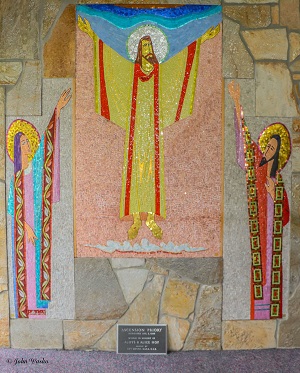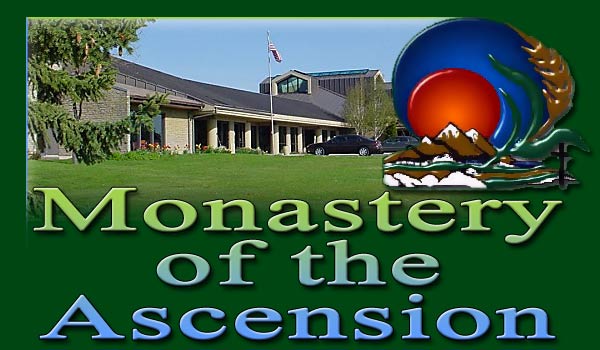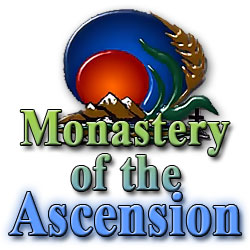The Life of Saint Benedict
Fr. Hugh Feiss, OSB
The Political and Ecclesiastical Setting
Benedict's dates are usually given as 480--550. It seems quite clear that he lived within that time span, though we don't have a great deal to go on. St. Antony was a very old man when he died in 356. So Benedict lived about 200 years after Antony. Between Antony's time and Benedict's, some momentous things happened to the Roman Empire and Christianity.
The western half of the Roman Empire ceased to exist as a cohesive political entity. Various barbarian tribes invaded Western Europe. The city of Rome itself was invaded in 410, and the shocked Roman government pulled home their armies, abandoning England and other outlying regions. When St. Augustine died in 430, the Vandals were besieging his city of Hippo. Attila, the leader of the Huns, threatened Rome in 452; in 455 it was sacked by Gaiseric, the Vandal. The last Roman emperor in the West was deposed in 476. In 493, Theodoric, the leader of the Ostrogoths became ruler of Italy. The Emperor Justinian (d. 565) tried to reconquer Italy about the time St. Benedict died and his efforts savaged the country. Justinian's armies managed to establish a Byzantine presence there that lasted until the 11th century. Meanwhile, Christianity became the official religion of the Byzantine Empire.
Most city dwellers in the West were Christians by time of Benedict, but city life was in decline because of invasion and war. A series of councils--Nicea I (325), Constantinople I (381), Ephesus (431) and Chalcedon (451) had pretty well defined the key elements of Christian belief regarding God and Christ. However, there were still great struggles in the Eastern part of the Empire, especially between Greeks who accepted the teachings of these councils, and non-Greek Christians who did not. Many of the tribes who invaded Western Europe were still Arians, who did not accept the teaching of these councils about Christ and the Trinity. This changed gradually during Benedict's lifetime, as Catholic Christianity replaced Arianism among the invaders.
Meanwhile, during the 200 hundred years between St. Antony and St. Benedict monasticism had spread throughout the Christian world. We can make a little chart to show how monasticism spread to the Latin-speaking world:
250?
Pioneer male ascetics and female virgins and widows Origen (d. 254)--theologian
300s
St. Pachomius (d. 346)--community St. Antony the Hermit (d. 356) St. Basil of Caesarea (d. 379)--service St. Gregory of Nyssa (d. 395)--mysticism Evagrius of Pontus (d. 390)--Origenist theologian/monk: 8 thoughts St. Martin of Tours (d. 397)--monk/bishop; model for saints' lives
400
John Cassian (d. 430)--Lérins near Marseilles (East-->West) St. Patrick (5th c.)
500
Benedict (d. 550)--Lombards destroy Monte Cassino. 585 Cassiodorus (d. 584)--learning & monasticism Columcille (d. 597)--monastery of Iona Columbanus (d. 615)--Irish missionary to continent; rule
Benedict's Life
Around 593, Pope Gregory I (pope from 590, d. 604) wrote a book called the Dialogues, which aimed to provide examples of miracle working saints who lived in Italy in times recent to his own.1 The Dialogues are divided into four parts, of which the second is devoted only to St. Benedict. There Gregory tells Benedict's story in 38 brief chapters.
The world in which these miracles take place is one of ruins and devastation. Gregory writes to people open to the presence and working of an invisible world. Gregory sent a copy to Theodelinda, the Catholic queen of the Arian Lombards who were ascendant at the time. The stories have a popular, folkloric quality, but Gregory wrote them very carefully. The miracles he tells often and deliberately resemble those described in the Bible. Gregory's aim is to lead the reader from the external event or sign to their spiritual signification. Some of the miracles are, in fact, purely interior events. Gregory wanted to incite his readers to a deeper spiritual life. He says he received his information about Benedict from many different people, especially a succession of abbots at a monastery at the Lateran.
Benedict is presented as a precociously wise young man, born of a well-to-do family who sent him with a nurse, maid or governess to study in Rome. The decadence of the students there repelled him, and he abandoned studies, family and inheritance to devote himself to pleasing God. He and his maid went to Affile, about 40 miles from Rome. There they lived at a church. When the woman broke a borrowed, ceramic sieve, Benedict prayed over it and it was completely mended. This brought Benedict popular esteem, so he left his maid behind and went about six miles away into the "desert." "Desert" here, as often in monastic literature, doesn't mean a windswept waste, but anywhere apart from other people. Benedict went to Subiaco, which in Latin means "below the lake." Subiaco was so named because above the cave where he stayed was an artificial lake which was part of a ruined imperial villa. A monk name Romanus brought him food, and a priest and some shepherds also helped him. Benedict stayed there for three years. There in his desert, Benedict struggled against temptation to distraction (symbolized by a black bird he sent away by making a sign of the cross) and by sensuality that he overcame by rolling in brambles.
Next, some nearby monks wanted him to be their abbot. He resisted, but eventually gave in. Benedict proved to be too strict, and they tried to poison him. The cup broke when Benedict made the sign of the cross over it. He quietly said goodbye and went back into solitude, he withdrew to be with himself, Gregory says. The broken cup is one of the usual features of paintings and statues of St. Benedict. But more people were drawn to him, and he ended up building 12 monasteries for them. Gregory then tells of four miracles Benedict worked at these new monasteries, several of them concerning two young disciples from Rome, Maur and Placid, whose parents sent them to Benedict "to rear for the Lord."
The priest of a neighboring church began to be jealous of Benedict. He sent Benedict a loaf of poisoned bread. A crow used to come at mealtime to be fed by Benedict, so Benedict gave it the bread and told it to take it where it wouldn't hurt anyone. For this reason, a crow is another frequent feature of artistic representations of St. Benedict. Benedict decided to leave again quietly. When Benedict had gone a few miles, the Priest's house collapsed and squashed him, which saddened Benedict.
Benedict settled on Monte Cassino, a 1,000-foot high hill on a main road between Rome and Naples. He converted two pagan temples there into chapels in honor of John the Baptist and St. Martin. Then most of the rest of Gregory's account is devoted to Benedict's miracles and prophecies on behalf of men and women that Benedict worked there as he supervised the building of a monastery and guided his monks. He preached to the local population. Totila (King of the Ostrogoths, 541-552) visited Monte Cassino, and Benedict foretold his conquest of Rome and his death 10 years later.
Gregory's story of Benedict's life concludes with two very moving stories. Benedict's sister (this is the first we've heard of her) used to come once a year to speak with Benedict about holy things. They had a meal and talked. On this occasion she asked him to stay longer and talk through the night, but he said that was impossible. She put her head in her hands on the table and prayed fervently. A huge thunderstorm came, and Benedict couldn't leave. Gregory draws several morals from this. Saints don't always get what they want. "She was able to do more because she loved more." In the other story, Benedict is praying in his room at the top of a tower. All of a sudden in the middle of the night he saw a great light in the sky. "The whole world was brought before his eyes, gathered up, as it were under a single ray of sun." Gregory remarks: "The whole of creation will seem small to the soul who sees the Creator, ... because in the very light of the internal vision the capacity of the soul is enlarged." Near the end of his story, Gregory remarks that Benedict wrote "a rule for monks, remarkable for its discretion."
Placid and Maur
Maur and Placid [Latin: Maurus and Placidus] appear in the life of Benedict in the Dialogues. They are involved series of four miracles which Gregory locates at Subiaco. Maur is said to have been the son of Euthicius, a Roman, who entrusted his upbringing to St. Benedict. Similarly, the patrician Tertullus offered his young son Placid. Maurus, who was well-behaved, seems to have become Benedict's assistant at Subiaco (Dialogues 3.14). In the first miracle, Benedict goes to help a monk who could not sit still for prayer. Maur, the servant of God was there on that occasion and saw the same vision of the devil that Benedict did. In the second miracle, a Goth, who had become a monk, lost the metal part of his brush cutter when it flew off into the lake. He told Maur, who told Benedict (6.2). Placid accompanied Benedict on another occasion, when he went up on a rocky summit where the monks could find no water and prayed that they might have water (5.2). Finally, on another day, Placid was getting water from the lake, fell in and was swept out from shore. In a vision, Benedict saw what was happening and sent Maur to save Placid. Maur walked across the water without realizing it and brought Placid back to shore. When he came back to the shore and "returned to himself," Maur attributed the miracle to Benedict's command; Benedict said it was because of Maur's obedience. Placid, however, said that when he was being pulled from he water, he saw the abbot's cloak over his head. Later, when Benedict decided to leave Subiaco, Maur was glad when the envious priest who had forced Benedict to leave was killed when his house collapsed. Benedict, who was sad, imposed a penance on Maur for this.
Adalbert de Vogüé has analyzed these stories carefully.2 He thinks that one of the morals is that Benedict, who had wisely cut short his education in Rome, now becomes an educator of the children of Roman families. Maur and Placid were the subject of later, elaborate legends, which associated them with France.
The Significance of Gregory's Account of Benedict's Life
Gregory's picture of Benedict corresponds in many ways to the picture presented in the Rule of Benedict. As the stories of Maur and Placid indicate, obedience and humility are key virtues in Benedict's Life as well as in his Rule. However, as one scholar points out, in the Life Benedict "appears not as a paragon of cenobitical stability but as a charismatic wilderness-dwelling hermit." The Dialogues were widely read, and Benedict's Life seems to have exerted considerable influence, especially in Italy, where many Benedictine saints of the early Middle Ages were hermits. In the tenth to twelfth centuries, Gregory's account of Benedict's life was a very important model for other saints' lives, and presumably for the saints who read those lives; e.g., St. Peter Damian's Life of Romuald and the Life of Dominic of Sora. Joachim of Fiore and St. Francis also seem to have been influenced by The Life of Benedict, as were the accounts of the life of Peter of Morrone (d. 1296), who was briefly Pope Celestine V.
This is another side of the Benedictine tradition, which is both more solitary and more directly pastoral, prophetic and colorful. Although this has not been the dimension of Benedictinism to the fore since the Renaissance, the Life of Benedict is a wholesome reminder of how complex and varied is the Benedictine tradition.


